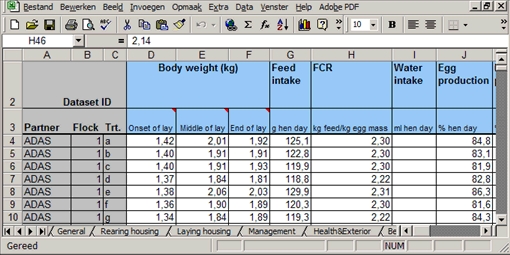Data Collection
At the start of the LayWel project it was recognized that drawing general conclusions with regards to welfare of hens in various housing systems could only be done on the basis of a large amount of data.
The partners of LayWel had access to the results of many studies, both finished and ongoing. To enable the collection of these data a centralised, web based Excel database was developed in project year 1 into which all partners entered their own data. This facilitated for the work in WP3 (health/exterior), WP4 (behaviour), WP5 (physiology), WP6 (Production) and WP7 (welfare assessment).
A lot of effort was put in the set-up of this database to ensured a uniform data format, which made comparisons between studies and potential meta-analyses of the available data possible. The data base design and data entry process was managed by ADAS.
The database comprises results of many studies on housing of laying hens in various European countries. The data are collected both on commercial farms and in experimental units. The database is unique for several reasons: 1. the data origin from studies on all type of housing systems, with special emphasis on furnished cages; 2. the data come from different countries all over Europe; 3. the database contains data on many topics, ranging from production to behaviour.
A problem with a database like this is that the data origin from many different sources. Housing conditions, management, type of hen, type of feed all differ. This makes it extremely difficult to draw sound conclusions. Only people who know the background of the data, who know how studies were done and what has happened in the experiment can judge the data right. Therefore the database is only open to partners of the LayWel project, who on their turn will not use the database without consulting the other partners. Each partner remains owner of its own data. In this way misusage and wrong conclusions are prevented.
The value of the database already has shown in the LayWel project, when welfare of laying hens was evaluated. However, although even new and unpublished data were put in the database, still the feeling was that for some systems (especially large furnished cages) data were missing and more data may change the conclusions. Also a distinction should be made between old and new data, as the rapid development of housing systems may outdate certain research results, making it necessary to exclude them from the analysis. As the demand for up-to-date figures remains vivid and new data are produced frequently, frequent updating of the database would provide a very valuable scource of information to both the industry and governments with regards to:
- the state of the art of modern laying hen keeping
- strong and weak aspects of various housing systems
- influence of enrichement components or other details of housing on performance and welfare of the hens
- details that need special attention
An up-to-date database would make it very easy to give quick updates on the welfare of laying hens in various housing systems.
Because of the great value of continuing the work on the database a way is sought to keep the database updated. This is the reason why the database is registered as an exploitable result looking for further support.